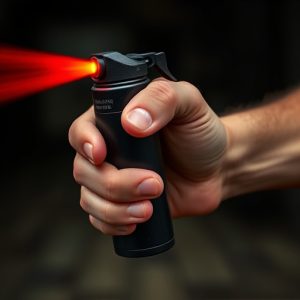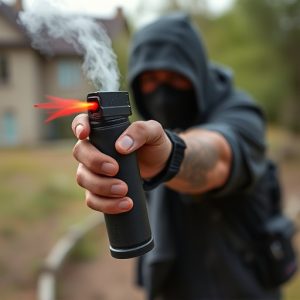Tactical Reloading Pepper Spray Canisters: Law Enforcement’s Rapid Response Weapon
Tactical reloading pepper spray canisters, deployed from specialized devices, offer law enforcement…….
Tactical reloading pepper spray canisters, deployed from specialized devices, offer law enforcement enhanced accuracy and efficiency compared to traditional aerosol cans. Modern designs prioritize precision and minimize off-target effects, improving safety and effectiveness in diverse scenarios. Effective training and regular practice are crucial for officers to maximize the benefits of tactical pepper spray deployment. Rigorous training ensures safe and responsible use, while legal implications and regulatory standards guide procurement and deployment, with strict measures to maintain quality and compliance across jurisdictions.
“In the realm of law enforcement, tactical reloading pepper spray canisters have emerged as a pivotal tool for rapid response and crowd control. Understanding this powerful yet controversial weapon is crucial for officers aiming to maintain public safety effectively. This article delves into the evolution of pepper spray technology, from its tactical applications to the intricate process of reloading. We explore design advancements, training considerations, legal implications, and more, shedding light on why efficient tactical reloading of pepper spray canisters is an indispensable skill for modern law enforcement officers.”
- Understanding Tactical Pepper Spray: A Law Enforcement Perspective
- The Evolution of Pepper Spray Canisters: Design and Efficiency
- Reloading Techniques: Ensuring Rapid Response for Law Enforcement Officers
- Safety and Training Considerations for Effective Use
- Legal Implications and Regulatory Standards for Pepper Spray Weapons
Understanding Tactical Pepper Spray: A Law Enforcement Perspective
Tactical pepper spray is a powerful tool in the arsenal of law enforcement agencies worldwide. It’s designed for effective crowd control and individual incapacitation, allowing officers to temporarily disable suspects while maintaining a safe distance. Unlike traditional pepper spray, which comes in aerosol cans, tactical pepper spray is typically reloaded canisters that are fired from specialized devices, like a balling gun or launcher. This method offers several advantages: improved accuracy, reduced risk of off-target effects, and the ability to deploy the spray more efficiently in various scenarios.
From a law enforcement perspective, understanding the tactical reloading pepper spray system is crucial for operational safety and effectiveness. Officers need to be trained on the proper use of these devices, including technique, range, and decontamination procedures after each deployment. Regular practice with simulated scenarios ensures that officers are prepared to respond swiftly and accurately in real-world situations, making tactical pepper spray a valuable asset in maintaining public order and officer safety.
The Evolution of Pepper Spray Canisters: Design and Efficiency
The evolution of pepper spray canisters, or tactical reloading pepper spray canisters, reflects advancements in law enforcement tactics and technology. Early designs focused on delivering a powerful but relatively uncontrolled stream of pepper spray, aiming to incapacitate subjects quickly. Over time, these have transformed into more sophisticated tools, emphasizing precision and efficiency. Modern canisters employ advanced mechanisms, such as adjustable nozzles and improved formulations, allowing officers to target specific areas with greater accuracy while minimizing off-target effects.
This refinement in design translates directly into enhanced efficiency on the ground. Tactical reloading pepper spray canisters now offer faster deployment times, reducing the risk of both subject escape and potential injury to bystanders or fellow officers. Moreover, the improved formulations ensure longer-lasting effectiveness, enabling law enforcement personnel to maintain control in challenging situations more effectively.
Reloading Techniques: Ensuring Rapid Response for Law Enforcement Officers
For law enforcement officers, quick and efficient deployment of pepper spray is crucial during high-stress situations. This necessitates a deep understanding of tactical reloading techniques for their pepper spray canisters. Officers need to be adept at swiftly changing empty or partially used canisters, ensuring they have continuous access to this powerful less-lethal tool.
Effective tactical reloading involves training officers to quickly identify and secure the correct replacement canister, while minimizing disruption during a dynamic scenario. The ability to reload rapidly enables officers to maintain control and respond to threats promptly, enhancing their overall effectiveness in various law enforcement operations.
Safety and Training Considerations for Effective Use
The safe and effective use of tactical reloading pepper spray canisters requires rigorous training for law enforcement officers. It’s paramount to equip officers with comprehensive knowledge about the canister’s mechanics, including its range, stop-power, and de-escalation capabilities. This involves scenario-based training that mimics real-world situations, allowing officers to practice target acquisition, trigger control, and proper distance management while minimizing collateral damage.
Regular refreshers and specialized workshops are essential to keep officers adept in pepper spray application techniques. These sessions should emphasize safe handling procedures, canister deployment strategies, and post-application de-escalation tactics. Moreover, fostering open dialogues about the potential side effects of pepper spray and its impact on different individuals is crucial for responsible use, ensuring both officer safety and community well-being.
Legal Implications and Regulatory Standards for Pepper Spray Weapons
The legal implications and regulatory standards surrounding tactical reloading pepper spray canisters are crucial considerations for law enforcement agencies and officers. Each jurisdiction has its own set of rules and regulations that dictate the use, possession, and distribution of pepper spray as a weapon. These laws often include specific requirements for training, storage, and deployment protocols to ensure safe and responsible use. Non-compliance with these standards can lead to legal repercussions, including civil liabilities and disciplinary actions against officers.
Regulatory bodies typically establish guidelines for the type of pepper spray allowed, its concentration, and the methods for deployment. Tactical reloading pepper spray canisters, designed for repeat use, must adhere to stringent safety and quality control measures. Manufacturers must ensure their products meet the defined standards, and law enforcement agencies are responsible for proper procurement, maintenance, and issue of these canisters to officers in the field.
Law enforcement agencies now have a powerful tool at their disposal with tactical pepper spray, as demonstrated by the evolution of spray canisters and reloading techniques. Understanding the importance of rapid response, safety protocols, and legal guidelines ensures that officers can effectively utilize this weapon while mitigating potential risks and adhering to regulatory standards. By staying informed about the latest advancements in tactical reloading pepper spray canisters, law enforcement professionals can enhance their capabilities and maintain public safety in today’s diverse and dynamic environments.


